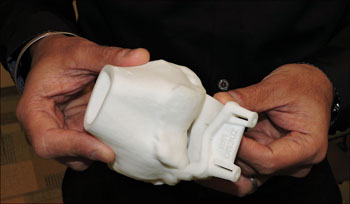3D Printed Models of DICOM Images Are Critical to Progress in Medicine According to Expert
By MedImaging International staff writers
Posted on 02 Mar 2016
The use of 3D printed models of DICOM images can change the way doctors are trained, and how they communicate with their patients.Posted on 02 Mar 2016
The research was presented at the annual meeting of the Radiological Society of North America (RSNA 2015). The research shows that despite the challenges that still need to be overcome before 3D models printing reaches its full potential in radiology, the impact of 3D printing could become the standard.

Image: 3D printed models are increasingly being used for planning complex orthopedic interventions (Photo courtesy of RSNA).
According to Frank Rybicki, MD, PhD, professor, Department of Radiology, University of Ottawa Faculty of Medicine (uOttawa; Ottawa, Canada), radiologists need to invest the time to learn 3D model printing methods. Dr. Rybicki suggests that printing of medical models from Computed Tomography (CT) and Magnetic Resonance (MR) images should become part of radiology departments. Advanced imaging modalities and protocols need to be able to generate source DICOM images that can be used for 3D printing. Radiologists could use 3D printed models of DICOM images for tactile feedback, and tangible depth information of anatomic, and pathologic states. Existing obstacles to the mainstream adoption of 3-D printing include a consensus in terminology, cost, training, materials, equipment, and guidelines.
Dr. Rybicki, said, “If we’re going to get reimbursement, we need a single reporting standard for 3D printing, and reimbursement will be a major hurdle. All payors know that we need 3D printing, and that it will eventually be reimbursed as the demand continues to swell. This will happen as we accumulate more data, and then develop guidelines regarding appropriate utilization. While there are many pressures to contain costs, data is beginning to show that the generation of 3D models is cost-effective for several applications, particularly when the model saves time in the operating room. 3D printing is a completely disruptive technology in general and in medicine. It will change the way that doctors do procedures. It will change the way we teach young physicians. The next natural step in the progression of technology is 3D printing.”
Related Links:
uOttawa














